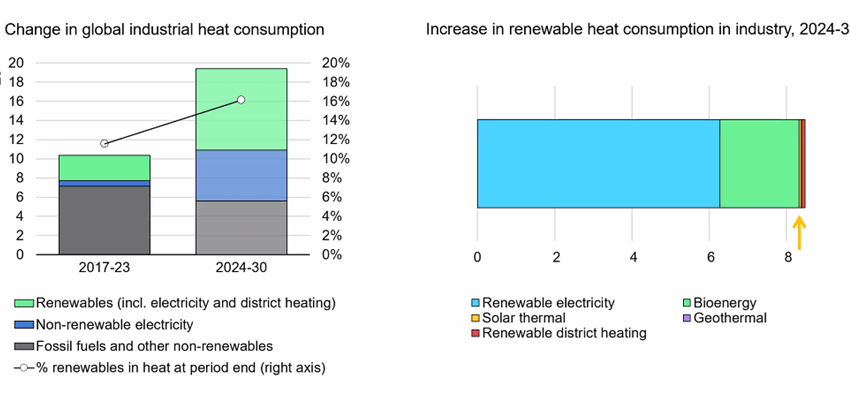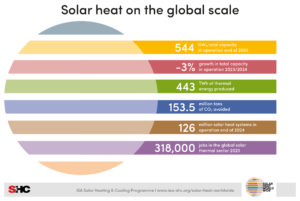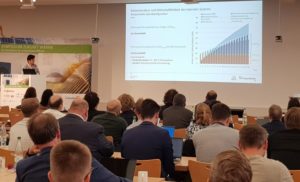Cost comparison of industrial heat from solar thermal and PV
January 6, 2025
The IEA predicts a 50 % growth in renewable industrial heat in the period 2024 to 2030 compared to the period 2017 to 2023 due to electrification (see chart above). PV and heat pumps should increasingly provide carbon-free heat for industries around the world. Solar thermal covers less than 1 % of this growth – but increases by a factor of six. This forecast is part of the Renewable 2024 report published by the IEA in October 2024. The German University of Kassel has compared the levelized cost of process heat (LCoH) provided by PV and solar thermal with a universal approach.
Source: IEA Report Renewables 2024
“We wanted to calculate what solar thermal energy should cost to show that it can be more favourable in relation to direct heat from PV systems”, said Prof Klaus Vajen from the University of Kassel, describing the approach. “As both solar technologies have hardly any operating costs, the levelized cost of heat depends mostly on the investment costs.” Vajen presented the methodology and results at a conference held by then IEA Solar Heating and Cooling (SHC) Programme in Berlin at the beginning of November.
The University of Kassel has developed a universal model for this purpose, which shows the investment ratio between a solar collector field and a PV field when both technologies achieve the same LCoH. Figure 2 shows the chart for evacuated tube collectors. “This chart, which our colleague Steven Meyers developed for his doctorate in 2018, is timeless and globally valid for this collector technology as long as there are no leaps in technology development in terms of the relationships kWh/m² or kWh/Wp”, explained Vajen.
The irradiation (y-axis) is essential for both solar technologies. The yield of solar thermal energy also depends on how far apart the ambient temperature and the desired process temperatures are, as this value influences the heat losses to the environment (x-axis). The heat from the PV electricity is generated using an immersion heater with nearly 100 % efficiency, regardless of the process temperature. The LCoH from a PV system is therefore only dependent on the irradiation and only to a very minor extent on the process temperature level due to heat losses.
To create this graphic the scientists from Kassel University calculated the relative plant investment of the two solar technologies required to obtain the same solar process heat costs. The ratio of investment costs in EUR/m² evacuated tube collector plant (aperture area) to EUR/Wp PV system is plotted in the chart. Steven Meyers used a discount rate of 6.4 % and 20 years life time for the LCoH comparison.

Figure 2: Universal model for evacuated tube collectors that shows the investment ratio for solar thermal versus PV dependent on the irradiation and the difference between the process temperature and the ambient temperature. Source: Kassel University
In figure 2 a solar plant in Zurich serves as an example. There, the sun provides 1,250 kWh/m² annually. The solar heating system needs to supply hot water at 75 °C, while the average ambient temperature is 15 °C, so the temperature difference is therefore 60 °C. If you set the PV plant costs at 1 EUR/Wp, you can read the chart easily. In this case the collector system could cost up to 500 EUR/m² aperture area to provide the same LCoH as the PV system.
Advantage for solar thermal energy at lower process temperatures
“Our approach illustrates that the lower the desired process temperature and the higher the ambient temperature, the more favourable is the cost ratio and LCoH for solar thermal energy as compared to PV”, summarized Vajen. With the same irradiation and a temperature difference of 40 °C (i.e. 55 °C process temperature), the ratio is 600 – the evacuated tube collector system can therefore cost 600 EUR/m². When the solar irradiation is lower, or process temperature higher, the ratio tilts to benefit the PV heating system. With solar radiation of around 1,000 kWh/m² in northern Germany, for example, a temperature difference of 60 °C already puts you in the turquoise-coloured range. The solar thermal system can therefore only cost around 450 EUR/m2, as the colour scale on the right-hand side of figure 2 shows.
In short: solar thermal energy tends to cost relatively more than PV heat in Norway as compared to southern Italy, given both the lower irradiation and ambient temperatures in the northern latitudes.

Figure 3: Investment costs for solar thermal systems with different collector types equalling process heat costs from PV of 1 EUR/Wp at Zurich, Switzerland Source: University of Kassel
At Zurich collector plant costs of less than 300 EUR/m² are cost effective compared with direct PV heating plants
Steven Meyers created universal charts with investment ratios for all collector technologies in his doctoral thesis. Figure 3 shows an extract of these results for the Zurich location. In this diagram, the coloured bands each show the investment ratio for which process heat costs are the same for a specific collector type and for PV. Here too, the basic statement applies that the collectors produce more expensive heat or generate less heat per square metre, when the process temperatures become higher. To remain competitive against PV heating, the collector project cost must decrease at higher operation temperatures, which is why the coloured bands fall steeply to the right. PV is more economical above the bands and solar thermal below.
In his presentation, Vajen now set average collector plant costs of EUR 400/m². In this case, flat-plate collectors are only cheaper than PV below 60 °C process heat. Vacuum tube collectors can also supply process heat at 85 °C to equal the heating costs from a PV system.
At solar thermal system costs of 300 EUR/m², which can certainly be achieved with large collector arrays today, solar thermal is, in all reasonable temperature levels, more cost effective than PV, shown on the dotted line in figure 3.
The news article was written in cooperation with Eva Augsten, renewable energy freelance journalist from Germany.
Organizations mentioned in this news article:
University of Kassel – Department of Solar and Systems Engineering: http://www.solar.uni-kassel.de
Download of doctoral thesis by Steven Meyers: https://kobra.uni-kassel.de/items/c35facf9-c218-4a47-a833-11ed95a4db1a
IEA SHC Programme: https://www.iea-shc.org/


